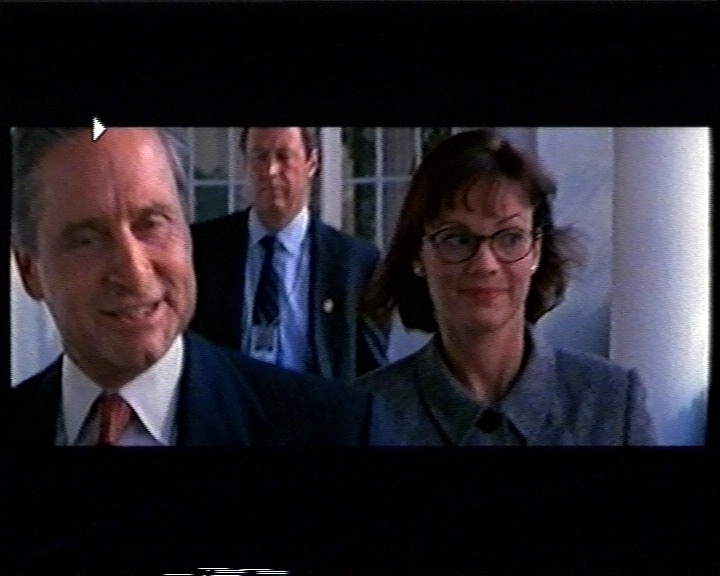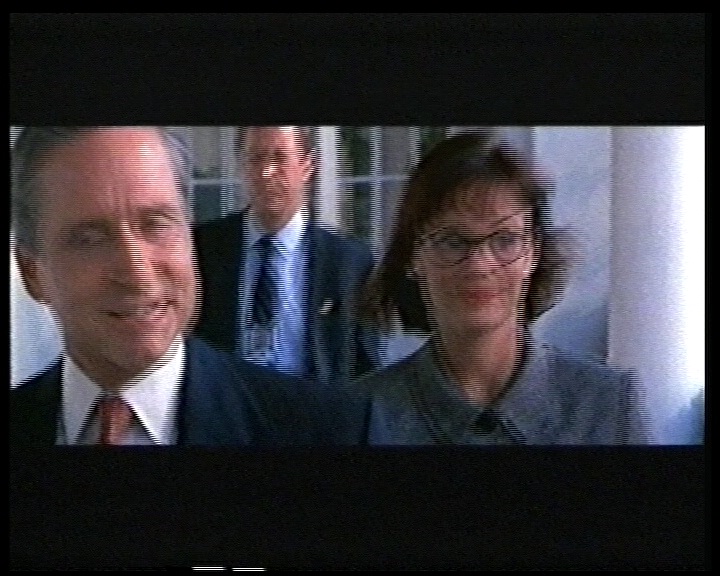I am capturing commercial PAL VHS tapes using an ADVC-100 capture card.
When the tapes are of poor quality, the capture card drops frames.
I understood while searching on another forum that a TBC (time base corrector) would solve the problem, so I purchased an AVDT-8710.
The problem of dropped frames is now solved, but the image looks has jagged edges.
My VCR does not have an S-video output, only composite which I am using to pass the signal through the AVDT-8710.
Could someone help me to solve the problem?[/img]
+ Reply to Thread
Results 1 to 14 of 14
-
-
Here an image from the movie "American President" as played on a PAL VCR and captured directly through the ADVC-100:

-
Here is the same image captured through the AVDT-8710 before passing to the ADVC-100:

-
I captured the video using WinDV and saved the images using VirtualDub.
The ADVC-100 creates an AVI file.
The final encoded MPEG-2 files burned onto DVD's, look about the same as the images, that is, with and without the AVDT-8710.
Thanks,
Chipsndukes -
virtualdub, by default, shows the interlacing. I suspect that your still cpas are simply a field or two apart and one shows slightly more interlacing than the other due to movement in the frame. certainly the TBC is not causing what you are seeing. It is inherent in all VCR captures.
Read my blog here.
-
Thanks guns1inger.
I don't understand interlacing very well, but know that when the video is captured with the AVDT-8710 in-line between the VCR and the ADVC-100 capture card, the AVI file looks like the second image--unwatchable.
The first AVI file (image 1), without the AVDT-8710, when encoded to MPEG-2 and burned onto a DVD looks very good (for a VHS) and motion is smooth with no jaggies.
The second AVI file (image 2), with the AVDT-8710 in-line, when encoded to MPEG-2 and burned onto a DVD is nearly unwatchable during motion scenes. There are jaggies and ghosting, looks very bad.
The only cure so far has been to deinterlace when encoding to MPEG-2, but the resolution suffers. I liked it better without the AVDT-8710 in-line, but then the capture card drops frames...
I hope this explains the trouble a little better...
Thanks to all who can help,
Chipsndukes -
The second image isn't unwatchable on your TV - it is how the tape looks being played back as well. The TV takes care of the display issue.
The only thing I can think off at the moment is that you are getting the field order screwed up. As you are coming through a DV converter, your signal should be bottom field first (BFF)Read my blog here.
-
Thanks again, guns1inger.
When the AVI file obtained with the AVDT-8710 in-line is encoded to MPEG-2 NTSC using the setting "bottom field first (field B)", the burned DVD plays fine on the TV even though it looks terrible on the computer. This would be good news except that the image "stutters" during motion sequences, probably a not-so-good frame rate conversion in the encoder (TMPGEnc).
So then encode to MPEG-2 NTSC with a frame rate of 25fps and use DGPullDown, but then the image is "unwatchable" again, even on the TV.
It doesn't matter in DGPullDown in the box "top field first" is checked or not.
The funny thing is, when encoded to MPEG-2 PAL, there are no problems. The image looks fine on the TV.
But the PAL video file takes more space for the same play time as the NTSC file and is not compatible with all my DVD players (that old story...)
I understood on another forum that the AVDT-8710 has a comb filter on the composite video input. I don't know what this means, but it may explain why with the AVDT-8710 in-line, the picture looks much different than without.
I personally think there is a field order problem as well, but do not know how to correct it.
I tried DGPullDown but it will only force "top field first", but not "bottom field first". I think if I could force "bottom field first" with DGPullDown, the problem would be solved.
But I don't know much at all about these things, am just theorizing......
Thanks again, guns1inger,
Chipsndukes -
The AVT-8710 can do PAL and NTSC so are you sure you have it set up correctly? I don't have the unit myself but my understanding is that it has an "auto" mode as well as a "manual" mode. I would manually set it to PAL format and try again.
As for doing PAL to NTSC with DGPulldown ... it requires that you encode the PAL video as PROGRESSIVE. If the PAL source is not PROGRESSIVE but is instead INTERLACED then you either need to deinterlace or do a IVTC to make it progressive 25fps before doing the conversion to MPEG-2 format (and make sure you resize to a NTSC resolution like 720x480).
A progressive MPEG-2 encode can be top or bottom field. It is more common to do top field. This is possible when the source is progressive (or made progressive) and the source being bottom field first interlaced is only a concern when selecting how to deinterlace or IVTC it. Once it is progressive it is progressive.
- John "FulciLives" Coleman"The eyes are the first thing that you have to destroy ... because they have seen too many bad things" - Lucio Fulci
EXPLORE THE FILMS OF LUCIO FULCI - THE MAESTRO OF GORE
-
It looks good when encoded as PAL because that is what it is.
When you encoded to NTSC then used DGpulldown - what did you actually do ?
To use this method you need to resize to 720 x 480 and encoded at 25 fps, then apply DGPulldown. Resizing interlaced footage must be done carefully, or you can screw the field order and make the image look pretty ugly.
What process did you use ?Read my blog here.
-
FulciLives, I read your post and thank you very much for answering.
The AVDT-8710 is set up as "PAL".
I'm don't understand yet the concepts of "progressive" and Inverse Telecine but I know where to find that information and I will read up.
Guns1inger, thank you again:
Current process is capture PAL VHS as AVI (DV Codec) with ADVC-100 using WinDV.
I use TMPGEnc and the standard template for DVD (NTSC) and only change the frame rate to 25fps. The video format is "interlaced".
When using 29.97 with TMPGEnc, the jaggies are gone but the picture "stutters" during motion sequences. I think the frame rate conversion 25->29.97 is not-so-good.
This is why the use of DGPullDown to avoid the frame rate conversion.
But it seems like the field order is different between actually encoding to 29.97fps and using DGPullDown.
The video "encoded" to 29.97 looks great (but stutters) while the video "pulled down" to 29.97 has jaggies.
Thanks so much both of you for the input. I'll keep experimenting, it will come to me.
Chipsndukes -
I wanted to answer my own post.
For those of you who read this and are helped, this is for you.
This isn't an extensive or technical answer, only how the problem was solved for me.
First of all, I still don't know why the input video looked the way it did with or without the AVT-8710, but I believe it is a field order thing.
Either way, manono was a great help in another post. If you want to know 100% what field order your input source is, use this AviSynth script:
AVISource("...\filename.avi")
AssumeBFF()
SeparateFields()
Run the clip in VirtualDub, if it is jerky, it is top-field first, if not, it is bottom-field first.
You can also write the script like this:
AVISource("...\filename.avi")
AssumeTFF()
SeparateFields()
I did that, writing both scripts and comparing the clip side by side on the monitor with two instances of VirtualDub running.
Conclusion: my DV file is BFF and therefore needs to be encoded as if the source file were that way.
So thanks, manono. Again. It's not the first time you have helped me.
Second conclusion was regarding converting the input DV file to DVD.
I wanted to do a conversion to NTSC using DGPulldown, but DUH, didn't read that only works for progressive material.
Using the technique above I compared what DGPulldown did to the field tags for interlaced material and they were all messed up, things jerking all over. Doesn't matter if you check the "Top field first" box on the program or not, same result.
Conclusion #2: for conversion of interlaced NTSC material, DGPulldown doesn't work. Duh, could have read the instructions to learn that.
So, finally, to make everything work together, I am encoding all to PAL. Resolution stays the same, frame rate stays the same. Result is just about the same crappy PAL VHS input that I had in the first place--what more can you ask for?
PS am running the encode on HCenc, looks good but a little slow compared to TMPGEnc CQ mode (for VHS cap. is OK) and the audio has to be stripped and encoded separately. Think because I have 200 tapes to do will use TMPGEnc.
I hope these ramblings will help someone out there with the same problems.
Oh yeah, the frame rate conversion with TMPGEnc is working fine, learned it is an absolute rule that any frame conversion from 25->29.97 will by nature be jerky during an pan sequence because you also have to add an extra frame which is a copy of one of the original frames.
Peace out,
chipsndukes -
PAL VHS videos from film sources can often be treated as progressive video.
In any event ... if you must convert to NTSC you would probably get better luck doing a deinterlace of the PAL video to make it progressive and then use the DGPulldown method.
- John "FulciLives" Coleman"The eyes are the first thing that you have to destroy ... because they have seen too many bad things" - Lucio Fulci
EXPLORE THE FILMS OF LUCIO FULCI - THE MAESTRO OF GORE
Similar Threads
-
TBC suggestions: TBC-1000, AVT-8710, ADVC-300, TV1-TBC, or TV1-TBC-GL
By m27315 in forum RestorationReplies: 16Last Post: 24th Mar 2010, 02:36 -
ATV-8710 TBC Info
By wahsac in forum RestorationReplies: 1Last Post: 29th Jul 2009, 00:50 -
AVToolbox AVT-8710 TBC
By maeks84 in forum RestorationReplies: 3Last Post: 28th Apr 2008, 01:37 -
Help with AVT-8710 TBC
By Reniamatic in forum RestorationReplies: 2Last Post: 17th Sep 2007, 16:26 -
new here how do i setup tbc AVT-8710 Urgently
By effects in forum RestorationReplies: 7Last Post: 6th Jul 2007, 14:21




 Quote
Quote